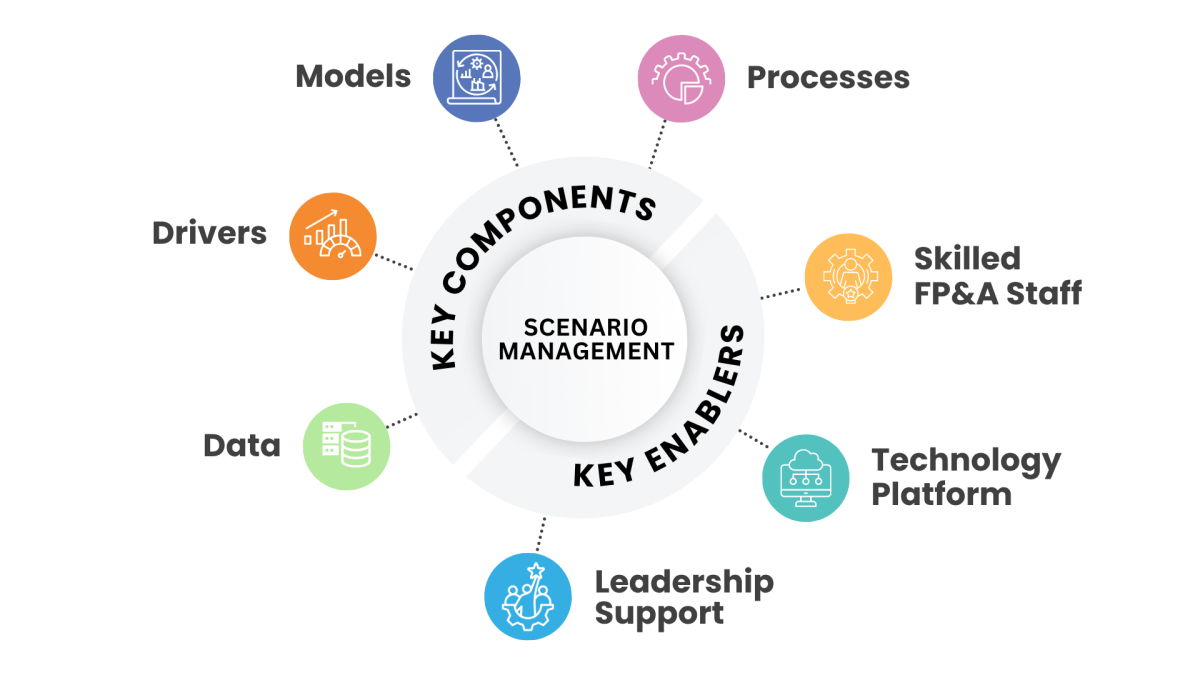This article looks at the key concepts and definitions of both integrated and agile FP&A...

Challenges and Solutions
Traditional planning is typically a rigid, corporate, financially focused framework for developing strategies, setting goals, and allocating resources. For most companies, it includes the rituals of annual budgeting, quarterly forecasting, and monthly reporting based on an assumed predictable future with one set of goals. Consequently, it lacks the flexibility needed for today’s uncertain world.
By contrast, Scenario Management is a more flexible approach that adapts to a constantly changing future and anticipates a range of possible futures. Using this, management is focused on what is driving performance and spends their time assessing and preparing plans that accommodate multiple realistic scenarios.
Unfortunately, the latest FP&A Trends Survey 2024 shows that 21% of organisations are unable to run scenarios at all, with a further 33% of organisations needing less than one week to produce a scenario. Only 22% can indeed run a scenario in less than one day. This lack of agility severely hampers how organisations manage uncertainty.
Components of the Scenario Management Approach

Figure 1
While Scenario Planning is commonly conducted by corporations to evaluate best, worst, and average future performance cases, Scenario Management, its less adopted cousin, takes this a step further. It is an adaptable, on-demand planning ecosystem that recognises a range of potential futures shaped by both internal and external performance drivers.
To this end, Scenario Management requires:
1. Access to Сlean and Timely Data
Data is the lifeblood of any planning methodology. However, our last FP&A Trends Survey revealed that 30% of respondents had no single source of trusted data. On top of this, 18% said the data collected was too complex, making analysis and reporting difficult, and 14% said there were too many inconsistencies in definitions and classifications. These data issues clearly need to be sorted out if organisations want to move towards fact-based scenarios. Yet it is not essential to wait for perfectly clean data - otherwise, the transition to Scenario Management will never take place.
2. Identifying Drivers of Performance
Identifying significant drivers, both internal and external, is key for building driver-based models that support Scenario Management. Drivers and their relationships can be uncovered by a combination of analytical review and discussions with relevant business users who are affected by them. Some organisations have already started to use AI/ML algorithms for this purpose. It should be remembered that historical data may not always reflect the future. That is why scenarios need to be run for a range of drivers.
3. Driver-Based Planning Models
Fully driver-based models are effectively ‘digital twins’ of the organisation that explain mathematically how inputs (e.g., raw materials and advertising campaigns) are related to outputs (e.g., turnover and gross profit). Driver-based models should be fully automated. While predicted driver values are entered, the model is capable of quickly calculating outcomes, producing a connected profit and loss (P&L), balance sheet, and cash flow statement. Models should be constantly checked for accuracy as results come in and updated accordingly.
Currently, the results of the FP&A Trends Survey show that only 9% of organisations have full driver-based models, and only 21% of all organisations surveyed have connected P&L, balance sheet, and cash flow statements. This needs to change if organisations are to take advantage of Scenario Management.
4. Scenario Development Process
Scenarios are developed in conjunction with business managers who review whether the AI/ML driver predictions are realistic. These predictions are then fed into the driver-based models. Results are subsequently reviewed by management to assess whether the resulting scenarios need to be refined. Once completed, plans are developed for the scenarios that deal best with predicted performance, taking advantage of an expected opportunity or overcoming a predicted challenge. The aim is to be ready for any scenario that materialises.
This process is valid at every level of the organisation. For example, scenarios may be managed purely within the production or sales area. However, it is important that results are fed through to other departments for feedback, if they are expected to be affected.
Key Enablers of Scenario Management
There are 3 key enablers for Scenario Management:
1. Senior Management Support
Senior management support is key to the success of Scenario Management since it represents a fundamental change to how an organisation plans. It requires management, at every level, to recognise that this is the only valid method of planning during uncertain times. Similarly, when performance is analysed, variances from target may not necessarily be deemed anyone’s fault without senior management support. It could be that the drivers chosen were incomplete, may have changed, or were not fully understood. Identifying and verifying drivers is everyone’s responsibility to ensure collective accountability.
2. Technology Platform
Many organisations continue to struggle with Scenario Planning due to outdated or overly complex systems. While modern cloud-based platforms offer a significant improvement in planning agility, only 18% of organisations currently use them, whereas 52% still rely primarily on spreadsheets, according to the latest FP&A Trends Survey. These traditional tools are not built for dynamic, real-time Scenario Management.
To enable effective Scenario Management, organisations need a unified planning platform — one that brings teams together around a single source of data, and equips them with the capabilities to model, test, and adjust scenarios quickly and consistently.
3. Skilled FP&A Staff
The last enabler is to ensure the FP&A team has the necessary time and skills to use modern, advanced analytics such as AI/ML algorithms. They also need to have solid business acumen and an understanding of the market so that they can engage with stakeholders from around the company and help identify, validate, and discuss drivers, along with the results produced.
Case Study
One manufacturer we interviewed found that traditional planning could not address an increasingly uncertain business environment. In response, they transitioned to Scenario Management, which involved the following:
- Identifying the key factors that affect outcomes.
- Using in-house AI predictive capabilities to quantify operational drivers.
- Defining assumptions and relationships that exist between drivers for scenario development.
- Incorporating sensitivity analysis to determine the range of potential outcomes.
- Developing execution plans for the most likely scenarios.
- Continuously assessing new information and market changes to understand their impact on performance.
The VP of FP&A at this organisation emphasised the importance of understanding the key drivers and assumptions used in Scenario Management. Without a clear understanding of these elements by the leadership team, there is always a risk of missing out on potential benefits due to an inability to evaluate the relationship between drivers and assumptions. The use of modern technology with real-time modeling is essential for a thorough analysis of the interrelationship between drivers and assumptions and for providing guidance during decision-making.
Conclusions
Scenario Management is a fundamental shift away from traditional, outdated planning practices. When implemented correctly, it can form the basis of a flexible, on-demand planning approach that acknowledges the potential of multiple futures.
The key requirements include access to clean, timely data, identification of performance drivers, fully automated driver-based planning models, and a collaborative scenario development process. Enabling Scenario Management requires support from senior management, a suitable technology platform, and skilled FP&A staff.
Embracing Scenario Management will help organisations transform the role of FP&A into an essential Business Partnering team that can effectively help them manage risks and capitalise on opportunities.
This article was first published on blog.board.com
Subscribe to
FP&A Trends Digest

We will regularly update you on the latest trends and developments in FP&A. Take the opportunity to have articles written by finance thought leaders delivered directly to your inbox; watch compelling webinars; connect with like-minded professionals; and become a part of our global community.






